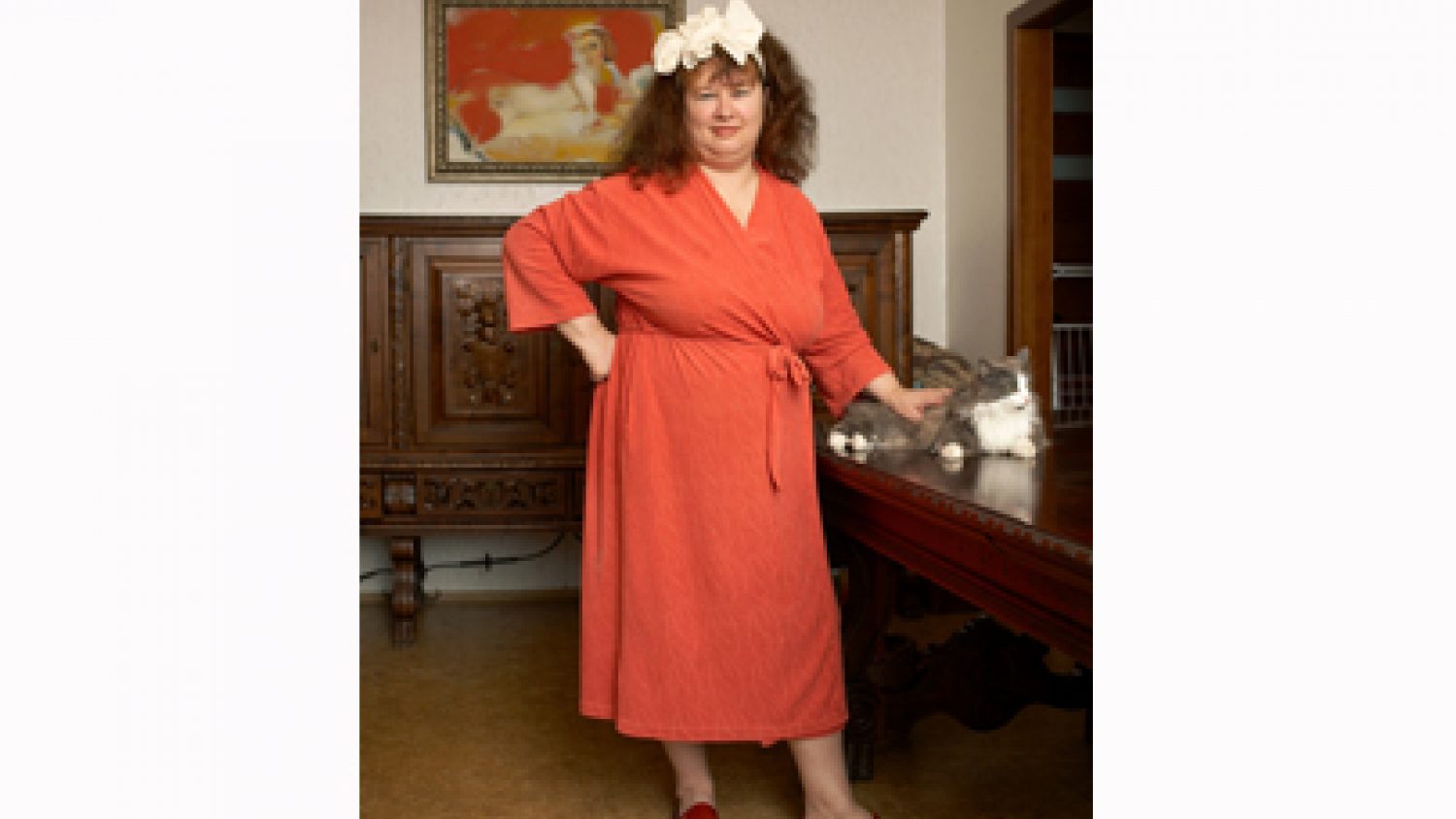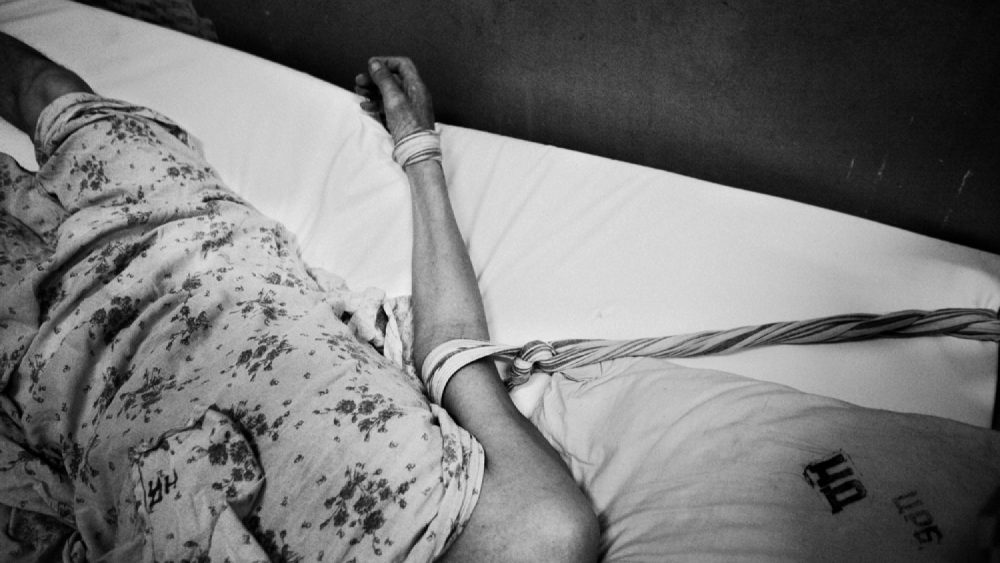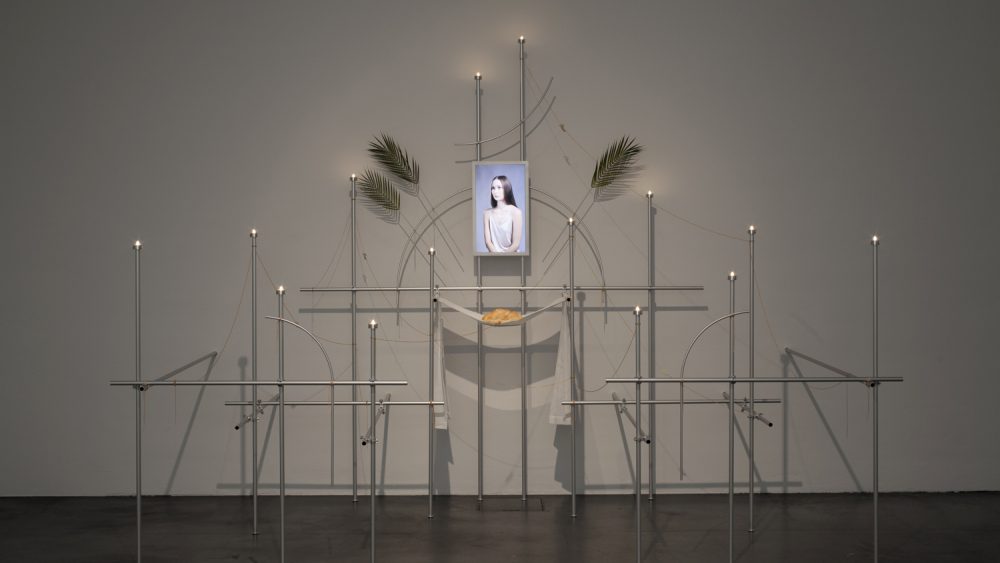Women in Dressing Gowns: Belarus Today
It is Dressing Gown that has eventually become Vitali Brusinski‘s (1969) calling card in the art world, summing up 20 years of his career in commercial photography. “The whole project is like a lively recollection of childhood,” Brusinski avows. “I grew up in kommunalka and I remember very well how women were running about there in dressing gowns. And if a gown was purchased abroad, it made a woman stand out from the crowd. The postures, head turns, gestures and walk of the lucky ones were expressive and arrogant. And their feeling of pride, as I’ve become aware of now, was probably caused by knowing that their remarkable gowns might be the source of envy of their neighbours”.
Brusinski’s memories of his Soviet childhood also reveal the images of the yard where the laundry was hang out for drying, a scene that Oxana Zhgirovskaja, the curator of exhibition Dressing Gown, tried to reconstruct in a small gallery of Belarusian Union of Designers which became the host for the first show of Dressing Gown in Minsk. It wasn’t, however, the first public display of the project itself. A year ago the students of the European Humanities University in Vilnius had a chance to practice their skills of art criticism through examining portraits of women in dressing gowns. After that Saint Petersburg Loft Project ETAGI welcomed the same exhibition at their art space.

From the very beginning Dressing Gown’s provocative stance has created a continuous intellectual reaction. Hot questions arose at the seminars on gender and visual arts that took place at Minsk Gallery Y, an oasis of contemporary art and education. Should the project be called discriminatory as it settles contemporary woman (among the models some Belarusian cultural activists can be recognized) in patriarchal, domestic routines? Is it a proper approach for contemporary portraiture? Another quite recent discussion was dedicated to the notion of the Soviet – the Soviet past, visible and invisible presence of the Soviet aesthetics, everyday culture and its remnants in the contemporary Belarus.
So how can Dressing Gown be contextualized? First and foremost, we see here a typical environmental portrait photography. The models are not invited to the studio, but it’s just the other way round a photographer is let in the subject’s natural environment – home, work or recreation settings. To give a better sense of the subject’s personality, the photographer provides an insight into the subject’s world. The tradition that can be probably traced back to Diana Arbus is constantly present in the best contemporary portraiture examples. If we look at the winners of the World Press Photo, Visa pour l’Image, Paris Photo, Les Rencontres d’Arles, there are Carlo Gianferro, Stephanie Sinclair, Rafal Milach, Willeke Duijvekam, to name just a few.
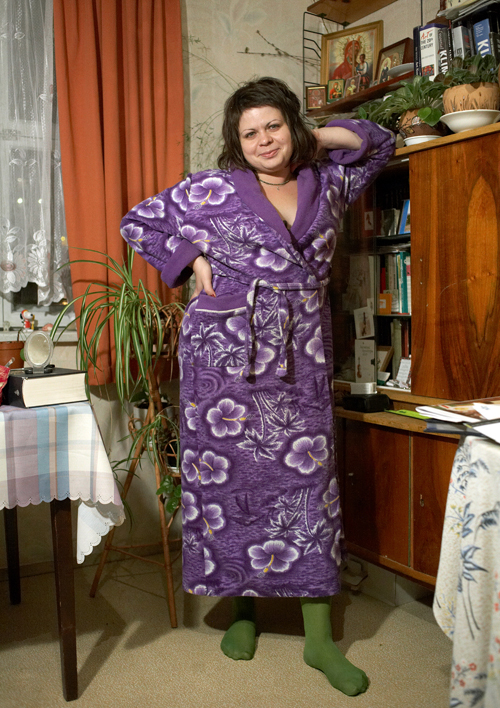
The background which is so essential for the environmental portraiture may though has different weights. Let’s look at the famous Zapis socjologiczny by Polish classic Zofia Rydet. In her portraits the background is overwhelmed with details to such an extent that a person is almost lost in a picture. The setting here doesn’t just provide an additional information about the subject but becomes the subject itself. Of course, in Brusinski’s portraits the interiors do not dominate the subjects like in Rydet’s case but it would be totally mistaken to put the apartments’ specificity in brackets is if it were a kind of noise distracting us from analysing the culture of dressing gowns.
Though Brusinski’s reason for selecting the subject matter is mostly sentimental, the artist’s adopted approach is neutral, emotionally detached, deadpan, and systematic. There is no irony or any vividly expressed individual photographic style. In most cases subjects remain expressionless and look straight into the camera. Brusinski confesses that his participation in orchestrating the scene was minimal and aimed only at maintaining the technical and compositional uniformity of the collected archive of images. The dressing gowns, postures and props were totally of the subject’s choice. The artist’s use of the frontal pose together with the most neutral and simple vantage point is arresting as it invites the viewer to feel the direct and frank relationship to the people portrayed. “Polemical narratives are raised for the viewer, but it appears as if this information is being given impartially,” argued Charlotte Cotton by describing deadpan aesthetics as one of the key styles in contemporary art photography.

The subject’s posing is, nevertheless, too obvious. Brusinski didn’t stop, in Joel Sternfeld’s manner, strangers passing by in the streets but carefully arranged his visits to women’s homes. As a result we witness a bizarre mixture of reality and imagination in final pictures. The portrait of Svetlana, the worker at a galvanizing plant, may raise suspicion that an artificial tangerine tree has been bought purposely to welcome a distinguished guest. An unemployed Valentina is holding a glass of wine, not a common drink for Belarusian family’s daily grind. And it’s probably not accidental that the student Anastasia has moved her diploma to the fore. But here again, as in case of interior landscapes, we can’t refrain the subject’s posing from noticing as it forms an additional layer of important meanings.
The way the subjects present themselves and consciously construct their images in front of the camera tells a lot about their vision of beauty, solemnity, and femininity. I love the story of taking a picture of Tia Maria that Julianne Newton shares in her book on photojournalism. While working on a long-term documentary project in Mexico, Newton observed Tia Maria every day and finally took a snapshot of what this Indian woman did daily – sitting outdoors and knitting. The picture was supposed to capture an authentic moment of a person’s everyday routine. But when Newton showed the photograph to Tia Maria for approval, the old woman was horrified and blamed Newton for humiliating her as a person by showing her in such an unattractive way. Newton proposed to take another picture next day, and this time Tia Maria was fully prepared – she invited the photographer to her apartment with nice furniture and family photos on the walls, she sat on a large coach, being dressed in a beautiful colourful dress and adopting an aristocratic pose. Was the portrait authentic this time? Indeed, but in a slightly different way than the former one – it shows the ‘moment of truth’ of how Tia Maria wanted to be seen.
But what role is played by a dressing gown in how Belarusian women wanted to be seen? An interesting article entitled Why Russian Women Wear Dressing Gowns at Home can be found on the website of a dating agency specializing on arranging the dates with ‘Russian women’. “If you were to visit a woman in Western Europe and your hostess opened the door in a dressing gown, you would think that you have arrived on the wrong day. In such a case a visitor would probably apologize politely and gracefully refuse to come in for a cup of coffee. A woman walking around her flat in a dressing gown might be either ill or just dragged herself out from a bed where she would like to return”, the article argues and cautions the clients that in Russia it is common to wear a dressing gown as a normal dress at home, a tradition that dates back to the time of the Soviet Union. Is it the case for Brusinski’s subjects as well? The artist and the curator insist on this. “I’ve never seen women wearing dressing gowns at home in the West. It’s totally our custom. And this custom is going to disappear,” Vitali says.
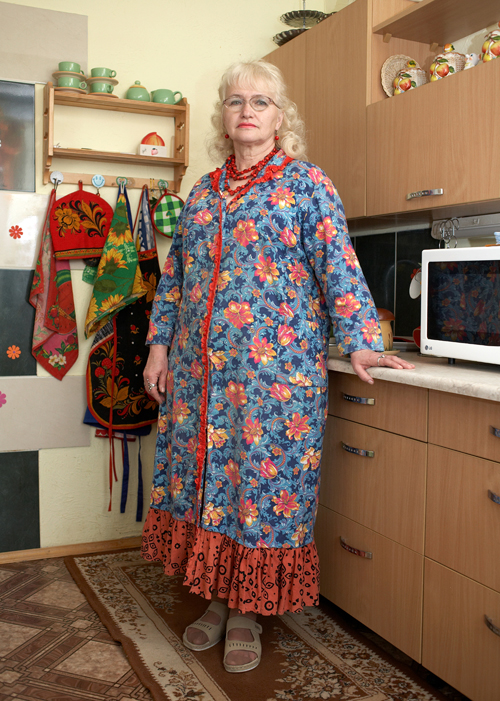
The trick, however, is in the fact that the subjects knew very well that the photographer is interested in the vanishing culture of dressing gowns, and more than that the subjects were asked directly to put on and demonstrate their own dressing gowns. A kind of similar approach was used by Lithuanian artist Ramūnė Pigagaitė in her project Cleaning Women. Being interested in the aesthetic of ‘multi-apartment houses painted in hysterical and crazy colours’, the photographer asked the women to put on their dressing gowns (of the same crazy colours) and pose for the camera while washing the staircases. Such an approach makes it impossible to claim that women still wear dressing gowns at home as a normal dress or that this is their particularly preferable way to be seen by the stranger.
Talking about the culture of dressing gowns, we have to admit that this robe can be absolutely contemporary. The world leading lingerie brands have gowns in their collections. However, the place and time of wearing contemporary gowns is clearly defined – it’s either a sleeping robe or a bathrobe. We can detect both types of dressing gowns in Brusinski’s visual encyclopaedia and assume they are strictly used for their intended purposes. At the same time, we can see there some old-fashioned robes, also known as dusters, a kind of protective clothing women wear while doing house chores. It is exactly the type of housecoat that Ramūnė Pigagaitė showed in her project as a symbol of household work, the robe that can be still found probably only in post-Soviet shops.
In the Soviet Union the dusters became widely acceptable not just as a robe for cleaning but as a dress for home. While intended to be cosy and practical, the dusters broadened their meaning to be all about beauty and femininity. In her comment on Brusinski‘s Dressing Gown project Olga Ronamova, the film critic and cultural studies scholar, featured flowery dusters as legacy of Soviet everyday aesthetics and ranked them together with colourful carpets, artificial flowers, and variegated wallpapers. This aesthetics, shared by the lower social class and reflecting the country people’s understanding of beauty (where beautiful means to be of vivid colours, realistic and sentimental, as Romanova summarizes), turned out to be the most stable.
The remnants of this attitude can be still found in contemporary Belarus and in Brusinski‘s portraits. “The Soviet today is Atlantis that has sunk into the ocean but on the surface we can still see its broken parts, froth, fragmented structures, signs that have lost their meanings, various social automatic behaviours,” Romanova argues; “In contemporary Belarus Atlantis has definitely sunk but its pieces are omnipresent, they cover everything like an oil spill”. If to look again at Svetlana’s portrait, we can, as Oxana Zhgirovskaja strongly recommends, detect the Soviet legacy in the very posture adopted by the subject. It is a typical posture, the curator argues, of the models in the Soviet fashion magazines of the 1970s, and it is precisely where Svetlana could unconsciously borrow it from.

The historian Aleksei Bratochkin discovers the remnants of the Soviet legacy in the interiors so thoroughly represented in the pictures. He refers to Ekaterina Degot, Russian art historian, who called the Soviet apartments ‘the museums of sentiments’. The Soviet people usually didn’t throw away anything that could elicit their emotions, thus accumulating a lot of diverse and seemingly useless stuff at their homes. According to Bratochkin, we can see this kind of apartments on some of the pictures. Another remnant of the Soviet culture is the presence of large home libraries which were the symbol of prestige and status and were not necessary connected with the profession of the apartment’s inhabitants. The post-Soviet apartments, though, are totally different, Bratochkin argues. They have undergone the so called ‘European-quality repair’ and have been cleaned out of all redundant stuff, even of libraries.
The photo captions add even more flavour to the project. The artist reveals his subjects’ first names together with their social position. Like in August Sander’s portrait of the society, we can find a mosaic-like collection of possible occupations a Belarusian woman can have: an administrative officer, a student, an artist, an editor, an actress, an engineer, a cook, a film producer, a doctor, and even the world champion gymnast. Each portrait can be seen as a complex depiction of a social type.
At its first display in Vilnius Vitali Brusinski‘s project was titled About the Dressing Gown. Later the curator abandoned the word ’about’ which made the whole conception much more complicated. What this project is actually about? About gender? About portraiture? About the Soviet culture? About remnants of the Soviet culture? About the contemporary Belarus? About social groups? About dressing gowns? Brusinski’s great success was in that he managed to penetrate the homes of Belarusian city dwellers and provide a documentation of their reality the way it is or the way it wants to be seen. Brusinski’s photographs are remarkably multilayered. We can see a lot there, a lot of facts, a lot of stories. The Dressing Gown project has just started to be prepared for display in Western Europe, and it’s interesting how the Western viewers will accept it, what kind of meanings they will detect as central.
